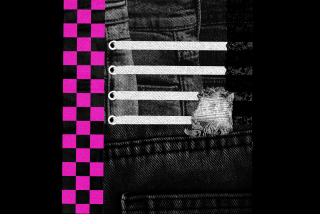Teen’s New Book Sends Message: Labels Are for Clothes, Not People
- Share via
NEW YORK — A label is flat, it has no depth and there is only room for one or two not-so-helpful words. Yet this tool is not only used to describe clothes but to put people in shallow categories.
Teenagers are particularly tempted to label their peers, says Aisha Muharrar, this year’s valedictorian at Bay Shore High School on New York’s Long Island.
“We’re at an age when we’re trying to find ourselves as individuals but have to conform right away to what our friends are doing. It can be confusing,” she says.
The 18-year-old challenges us all to look deeper than a shirt’s tag rubbing the back of one’s neck in a new book, “More Than a Label: Why What You Wear or Who You’re With Doesn’t Define Who You Are” (Free Spirit).
Muharrar based her book on a teen label survey she sent to 13- to 18-year-olds across the country. The questions mostly are about cliques, and clothes are often the easiest way to identify the different groups.
“Clothes are a major factor in forming labels. They’re based on where you’ve seen the clothes before. You see clothes that look like they’re from a rap video, you label them a hip-hopper, and you say they must be trouble,” she says.
“Preps,” whose wardrobe resembles a J.Crew catalog, are thought to be fans of lacrosse and tennis and to come from “old money.” They may also be called “Abercrombies,” referring to retailer Abercrombie & Fitch. There’s also the issue of how much clothing one wears--especially a girl if her midriff is bare and her skirts are short, Muharrar says.
The author, who will be a freshman at Harvard University in the fall, acknowledges that labeling has become part of daily life and “you’re not a horrible person if a label comes to mind when you see someone,” but she encourages using simple logic to bust stereotypes.
“Not every person who wears the same clothes can be the same person,” she says.
Take the plain, button-down white shirt as an example. According to Muharrar, all-too-simplistic labels say if the shirt is worn with khaki chinos, it signals a “prep”; if the rest of the outfit is black, the wearer could be a “goth.” But those super-preppy khaki pants become a “hippie” style if worn rumpled with a protest shirt, Muharrar says.
“These ‘rules’ show how ridiculous the labels are,” she adds.
Muharrar describes her own style as a “jeans-and-T-shirt girl,” but she also likes to wear skirts as an alternative to shorts during the summer.
Her mission to eliminate labels from teenagers’ vocabulary started in the eighth grade when Muharrar called a girl a “snob” while they were both at camp.
Muharrar went all summer without saying a single word to the girl--until the last week. When they finally spoke, Muharrar says she realized the girl wasn’t a snob at all.
Then came Columbine.
When the shooters in the 1999 tragedy at Columbine High School in Littleton, Colo., were called the “trench-coat mafia” because of their goth-style clothes, Muharrar took offense.
The clothes these troubled teens wore weren’t dangerous, she says, but teasing--which can turn into slurs--can contribute to the larger problem of teenage violence.
Muharrar says she goes to great lengths not to use labels or judge what kind of person someone is based solely on appearance.
In her book, she offers 25 ways to follow her lead. Lesson No. 1: “Smile or say hello to someone new every day. You’ll be surprised at how easy it is and what it might lead to--new friends, for instance.”
More to Read
Sign up for our Book Club newsletter
Get the latest news, events and more from the Los Angeles Times Book Club, and help us get L.A. reading and talking.
You may occasionally receive promotional content from the Los Angeles Times.







